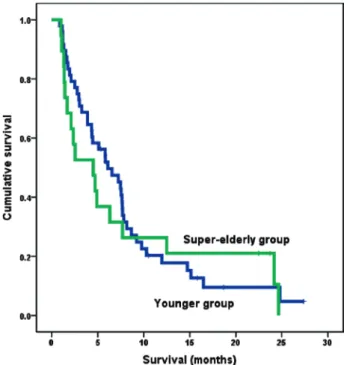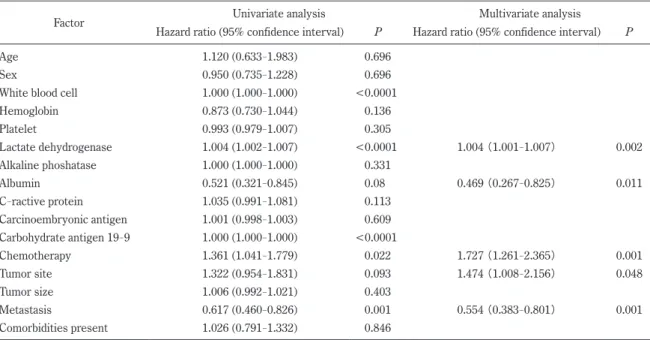Jikeikai Med J 2016
;63
:55
61
I
ntroductIonPancreatic cancer is the fourth most common cause of cancer
related mortality in the Western world. Unlike other cancers, pancreatic cancer has a mortality rate that has not decreased. In 2014, the number of deaths pancreatic cancer was related to was 39,590 in the United States, 73,439 in the European Union, and 31,716 in Japan in 2014, which in
dicate that this disease has a poor outcome
13.
The average human lifespan during the 20th century
has increased worldwide. Therefore, for elderly persons the treatment of cancer, including those with pancreatic cancer, has become a global problem. Several studies have shown that for treating pancreatic cancer in patients 80 years or older surgical resection is safe and achieves satisfactory outcomes
4,5.
However, because pancreatic cancer is often diagnosed at an advanced phase, many patients are not candidates for surgery. Moreover, elderly patients have comorbid diseases more often than do younger patients. To date, few studies Received for publication, March 23, 2016
上田 薫,木下 晃吉,小池 和彦,西野 博一
Mailing address : Akiyoshi
Kinoshita, Division of Gastroenterology and Hepatology, Department of Internal Medicine, The Jikei University Daisan Hospital, 4
11
1 Izumihoncho, Komae
shi, Tokyo 201
8601, Japan.
E
mail : aki.kino@jikei.ac.jp
55
Clinical Outcomes of Super
elderly Pancreatic Cancer Patients Who Are Not Considered to Be Suitable for Surgical Resection
Kaoru U
eda, Akiyoshi K
inoshita, Kazuhiko K
oiKe, and Hirokazu n
ishinoDivision of Gastroenterology and Hepatology, Department of Internal Medicine, The Jikei University School of Medicine
ABSTRACT
Background : To investigate the clinical features and prognosis of super
elderly patients who do not undergo surgical resection for pancreatic cancer, we performed a retrospective study evaluating the characteristics and outcomes of patients 80 years or older and younger patients.
Methods : The subjects evaluated were 67 patients who did not undergo surgical resection of a newly diagnosed pancreatic cancer. Of these patients 19 were super
elderly (age ≥ 80 years) and 48 were younger (age < 80 years). The differences in the overall survival (OS) rates between the groups were compared, and the prognostic factors were also evaluated.
Results : The OS rates did not differ significantly between the patient groups. Multivariate anal
ysis revealed that independent prognostic factors for the OS rate were the serum lactate dehydroge
nase level (hazard ratio [HR], 1.004 ; P = 0.002), serum albumin level (HR, 0.469 ; P = 0.011), che
motherapy (HR, 1.727 ; P = 0.001), tumor site (HR, 1.474 ; P = 0.048) and tumor metastasis (HR, 0.554 ; P = 0.001).
Conclusions : The lack of a significant difference in the OS rates between super
elderly patients and younger patients with pancreatic cancer who did not undergo surgical resection suggests that a super
elderly age alone should not restrict the therapeutic options.
(Jikeikai Med J 2016 ; 63 : 55
61) Key words : pancreatic cancer, elderly patients, clinical characteristics, prognosis, nonsurgical treat
ment
have investigated the clinical features and prognosis of pa
tients 80 years or older with pancreatic cancer who are not candidates for surgical resection
6.
Therefore, to investigate the clinical features and prog
nosis of such patients, in the present retrospective study we examined the characteristics and outcomes of super
el
derly patients and younger patients who did not undergo surgical resection of pancreatic cancer.
M
ethodsEnrolled subjects of this study were 96 patients who had received new diagnoses of pancreatic cancer and had been treated in our hospital from January 2011 through March 2015. The patients’ medical records were reviewed and analyzed. Of these patients, 18 patients were lost to fol
low
up and 11 who were treated surgically patients were excluded. Therefore, the remaining 67 patients were evalu
ated and divided into 2 groups according to their age at in
clusion : 19 patients who were super
elderly (age ≥ 80 years) and 48 patients who were younger (age < 80 years).
The diagnosis of pancreatic cancer had been confirmed with computed tomography or magnetic resonance imaging. The characteristics of the cancer, such as the site of primary tu
mor in the pancreas (head, body, or tail) and the level of progression (locally advanced or metastatic), had also been assessed with imaging techniques.
The study was performed in accordance with the stan
dards of the Declaration of Helsinki and was approved by our hospital’s institutional ethics board (28
107[8,350]).
The need for written informed consent for participation in this study was waived because this study was not a clinical trial and because the data was retrospectively collected and anonymously analyzed.
Blood samples had been obtained before the start of treatment to assess the levels of aspartate aminotransfer
ase, alanine aminotransferase, total bilirubin, lactate dehy
drogenase, albumin, C
reactive protein, white blood cells, platelets, hemoglobin, carcinoembryonic antigen, and car
bohydrate antigen 19
9.
Characteristics excluded from analysis were pretreat
ment comorbid diseases, including hypertension, diabetes mellitus, cardiovascular disease, cerebrovascular disease, renal failure and, other malignant neoplasms.
The decision for a patient to undergo nonsurgical treat
ment had been made according to factors associated with the patient (having a poor medical condition, being unable to undergo a major operation, or refusing to undergo surgi
cal resection) and factors associated with the tumor (pres
ence of remote metastasis or major vascular invasion [main portal vein, hepatic artery, celiac artery, or superior mesen
teric artery]).
The patients had been treated with best supportive care or palliative chemotherapy (gemcitabine or S
1 [tega
ful, gimeracil, and oteracil potassium] or both in combina
tion). The patients had been considered eligible for pallia
tive chemotherapy
7if they were 20 years or older and had adequate bone marrow and liver and kidney function (white blood cell count ≥3,000/μL, platelet count ≥10
4/μL, hemo
globin ≥8.0 g/dL, total bilirubin ≤2.0 mg/dL, aspartate ami
notransferase and alanine aminotransferase ≤100 IU/L, and serum creatinine ≤2.0 mg/dL). Before palliative chemo
therapy was started, percutaneous transhepatic or endo
scopic retrograde biliary drainage had been performed for patients with obstructive jaundice.
After the first treatment, the patients were carefully monitored, including with imaging techniques and tumor markers. For the patients who showed tumor progression, palliative chemotherapy or best supportive care was provid
ed. The start date of follow
up was when pancreatic cancer was diagnosed, and the end date of follow
up was the final follow
up examination in March 2015 or earlier in case of death.
Differences between the groups were analyzed with the Mann
Whitney U
test for continuous and ordinal vari
ables and the Chi
square test or Kruskal
Wallis test for cat
egorical variables. The overall survival (OS) rates were cal
culated with the Kaplan
Meier method and compared by means of the log
rank test. To evaluate prognostic factors, both univariate and multivariate analyses were performed with the Cox proportional hazard model. Variables found to be significant with univariate analysis were subsequently entered into a multivariate Cox proportional hazard model.
We performed subclass analysis to exclude the poten
tial effects of the treatment and remote metastasis on the OS rate. The OS rates of the two groups were compared ac
cording to the type of treatment (chemotherapy [n = 43, 64.2%], best supportive care [n = 24, 35.8%]). The OS rates of the two groups were compared according to the re
mote metastasis (absent [n = 21, 31.3%], present [n = 46,
68.7%]).
Statistical significance was indicated by P values
< 0.05. All statistical analyses were performed with the IBM SPSS Statistics software program, version 19.0 (IBM Corp., Armonk, NY, USA).
r
esultsAt first admission both of the serum hemoglobin level (P
= 0.046) and the percentage of patients undergoing chemo
therapy (P = 0.018) were significantly lower for super
elder
ly patients than for younger patients (Table 1). However, no significant difference between the groups was observed re
Table 1. Baseline characteristics of patients Characteristic Super
elderly patients (n=19)
n or median (range or percentage)
Younger patients (n=48)
n or median (range or percentage) P
Age (years) 83 (80
88) 72 (35
79) <0.0001
Male sex (%) 8 (42.1%) 27 (56.3%) 0.296
White blood cell count (/μL) 7,100 (4,200
26,300) 6,600 (3,400
22,700) 0.884
Hemoglobin (g/dL) 11.7 (8.6
14.8) 12.7 (8.7
16.9) 0.046
Platelet (10
4/μL) 21.2 (16
173) 22.7 (8.9
52.9) 0.482
Lactate dehydrogenase (U/L) 229 (154
823) 213 (127
1,969) 0.607
Alkaline phosphatase (U/L) 1,222 (158
3,041) 688 (173
5,699) 0.424
Albumin (g/dL) 3.5 (2.1
4.6) 3.8 (2.3
4.6) 0.079
C
reactive protein (mg/dL) 2.1 (0.1
13.3) 1.2 (0.1
24) 0.254
Carcinoembryonic antigen (ng/mL) 7.1 (3
135) 9.8 (1.6
2,224.9) 0.313
Carbohydrate antigen 19
9 (U/mL) 749 (1
53,609) 1,275 (1
566,900) 0.769
Chemotherapy (%) 8 (42.1%) 35 (72.9%) 0.018
Regimen of chemotherapy (%)
Gemcitabine 7 (87.5%) 20 (57.1%)
S
1 1 (12.5%) 3 (8.6%)
Gemcitabin+S
1 0 (0) 12 (34.3%)
Tumor site 0.28
Head 12 (63.2%) 25 (52.1%)
Body 2 (10.5%) 10 (20.8%)
Tail 4 (21.1%) 13 (27.1%)
Unkown 1 (5.3%)
Tumor size (mm) 38 (20
80) 37 (15
85) 0.889
Metastasis (%) 11 (57.9%) 35 (72.9%) 0.232
Reasons for nonsurgical treatment 0.15
Remote metastasis 11 35
Major vascular invasion 3 9
Others (poor medical condition or patient refusal) 5 4
Comorbidities present (%) (someoverlap) 13 (68.4%) 26 (54.2%) 0.286
Hypertension 9 (47.4%) 20 (41.7%) 0.671
Diabetes mellitus 4 (21.1%) 15 (31.3%) 0.404
Other malignant disease 7 (36.8%) 5 (10.4%) 0.11
Cardiovascular disease 0 (0%) 3 (6.3%) 0.265
Cerebrovascular disease 1 (5.3%) 3 (6.3%) 0.878
Renal failure 0 (0%) 2 (4.2%) 0.366
Patient outcome dead (%) 17 (89.5%) 42 (87.5%) 0.594
Cause of death (%) 1
Pancreatic cancer 17 (100%) 42 (100%)
Other cause of death


